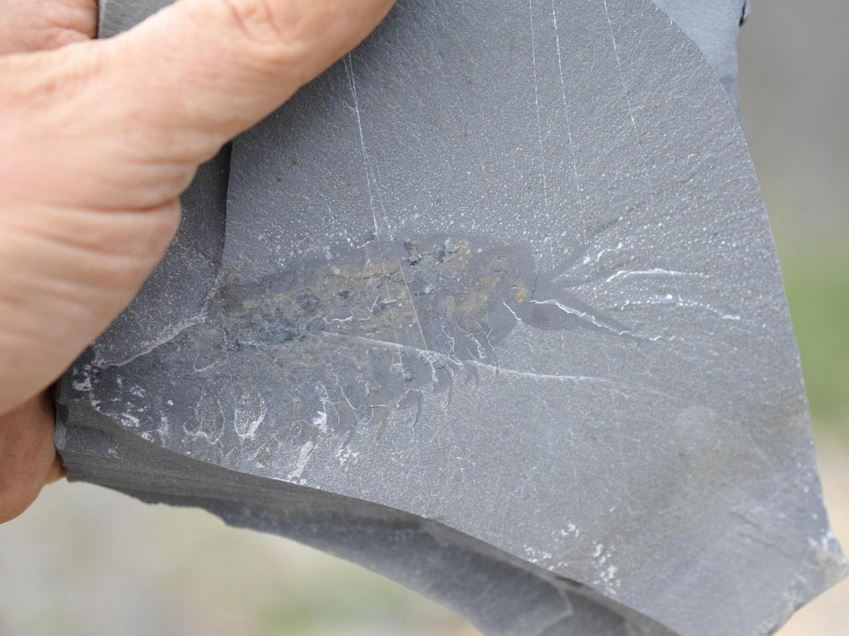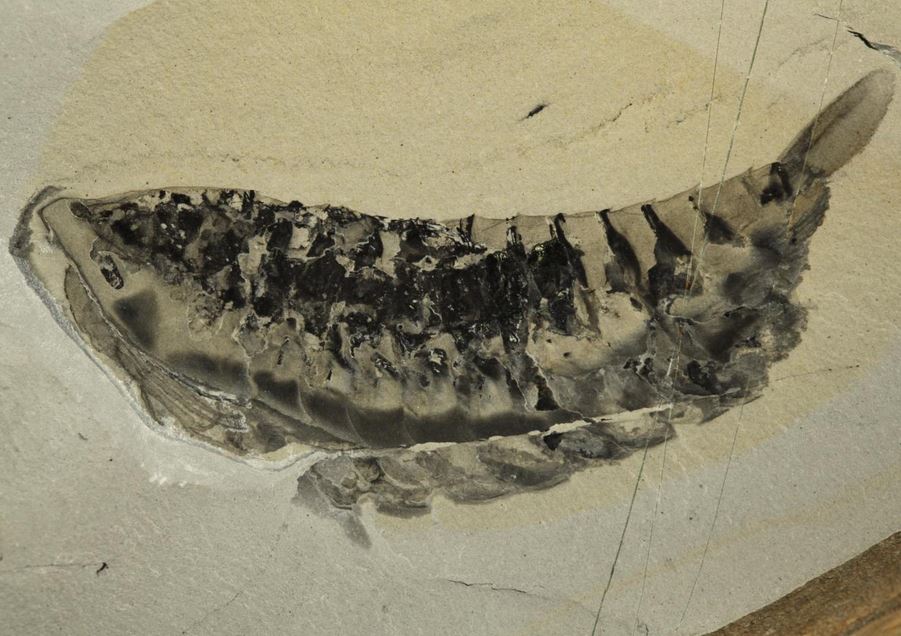A weird lobster-like predator with two pairs of eyes that existed 508 million years ago was an ancient ancestor of modern lobsters, spiders and butterflies, say researchers from Canada and the United States. It held a key position in the local food network.
The scientists discovered the fossil of a newly identified species called Yawunik kootenayi, a creature that lived in the water and had prominent grasping appendages (projecting parts). The predator existed more than 250 million years before the arrival of the dinosaurs.
The fossil was identified by a research team from the Royal Ontario Museum in Toronto, the University of Toronto, and Pomona College in California.

A freshly excavated fossil specimen of Yawunik kootenayi. (Image: Robert Gaines)
They say it is the first new species to be described from the Marble Canyon site, part of the famous Canadian Burgess Shale fossil deposit.
Yawunik had long frontal appendages that looked like the antennae of modern shrimps and beetles. However, those of this creature bore opposing rows of teeth that it used when catching prey.
The researchers have written about their finding in the academic journal Palaeontology (citation below).
Providing insight into the first arthropods
Lead Author, Cedric Aria, a University of Toronto PhD student at the Department of Ecology & Evolutionary Biology, said:
“This creature is expanding our perspective on the anatomy and predatory habits of the first arthropods, the group to which spiders and lobsters belong.”
“It has the signature features of an arthropod with its external skeleton, segmented body and jointed appendages, but lacks certain advanced traits present in groups that survived until the present day. We say that it belongs to the ‘stem’ of arthropods.”
The authors say that Yawunik kootenayi was able to move its frontal appendages forward and backward, spreading them out when attacking, and then pulling them in under its body when swimming.
It also had whip-like flagella (thread-like structures) extending from the tip of the claws, making its frontal appendages some of the most complex and versatile of all known arthropods.
Arthropods are cold-blooded creatures that have segmented bodies (made up of more than one part), many jointed legs, and an exoskeleton (external skeleton). About 85% of all known animals are arthropods. Examples include scorpions, barnacles, krill, crayfish, shrimp, crabs, lobsters, centipedes, ticks, mites, and spiders.
Mr. Aria said:
“Unlike insects or crustaceans, Yawunik did not possess additional appendages in the head that were specifically modified to process food. Evolution resulted here in a combination of adaptations onto the frontal-most appendage of this creature, maybe because such modifications were easier to acquire.”
“We know that the larvae of certain crustaceans can use their antennae to both swim and gather food. But a large active predator such as a mantis shrimp has its sensory and grasping functions split up between appendages. Yawunik and its relatives tell us about the condition existing before such a division of tasks among parts of the organism took place.”

A holotype of Yawunik kootenayi. (Image: Jean-Bernard Caron/Royal Ontario Museum)
Mr. Aria was part of a team that discovered the Marble Canyon site in 2012, led by University of Toronto’s associate professor Jean-Bernard Caron, and Robert Gaines, associate professor at Pomona College’s Department of Geology.
A big player in the local ecosystem
Prof. Caron said:
“Yawunik is the most abundant of the large new species of the Marble Canyon site, and so, as a predator, it held a key position in the food network and had an important impact on this past ecosystem.”
“This animal is therefore important for the study of Marble Canyon, and shows how the site increases the significance of the Burgess Shale in understanding the dawn of animals.”
The researchers had cutting-edge techniques for fossil imagery at their disposal, including so-called ‘elemental mapping,’ which can detect the fossil’s atomic composition, as well as that of the sediment surrounding it.
Prof. Gaines said:
“Our understanding of these organisms rests upon interpreting their fossil remains. These fossils are a composed of a mosaic of delicate original organic material and minerals that replicate parts of fossil anatomy.”
“The scanning electron microscope allows us to make maps of the fossils that reveal their composition. This gives us a remarkable perspective on the fossils, allowing anatomical structures to be visualized more precisely. This technique also provides insight into the unusual fossilization process that was at work here.”
Tribute to the Ktunaxa People
The new species is named in tribute to the Ktunaxa People who long inhabited the Kootenay area where the Marble Canyon is located.
The creature owes its name to Yawunik, a mythological figure described as a massive, ferocious marine creature that killed and caused such mayhem that it sparked an epic hunt by other animals to eliminate it.
Donald Sam, Ktunaxa Nation Council Director of Traditional Knowledge and Language, said:
“Yawunik is a central figure in the Ktunaxa creation story, and, as such, is a vital part of Ktunaxa oral history. I am ecstatic that the research team recognizes how important our history is in our territory, and chose to honour the Ktunaxa through this amazing discovery.”
Citation: “A large new leanchoiliid from the Burgess Shale and the influence of inapplicable states on stem arthropod phylogeny,” Cédric Aria, Jean-Bernard Caron andRobert Gaines. Palaeontology. Published 27 March 2015. DOI: 10.1111/pala.12161.
Video – Yawunik kootenayi
This Royal Ontario Museum video is an animated artist’s impression of Yawunik kootenayi walkcycle.

